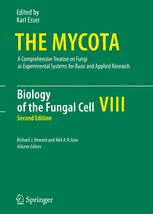
Biology of the Fungal Cell PDF
Preview Biology of the Fungal Cell
The Mycota Editedby K.Esser The Mycota I Growth,DifferentiationandSexuality 1steditioned.byJ.G.H.WesselsandF.Meinhardt 2ndeditioned.byU.KüesandR.Fischer II GeneticsandBiotechnology Ed.byU.Kück III BiochemistryandMolecularBiology Ed.byR.BramblandG.Marzluf IV EnvironmentalandMicrobialRelationships 1steditioned.byD.WicklowandB.Söderström 2ndeditioned.byC.P.KubicekandI.S.Druzhinina V PlantRelationships 1steditioned.byG.CarrollandP.Tudzynski 2ndeditioned.byH.B.Deising VI HumanandAnimalRelationships 1steditioned.byD.H.HowardandJ.D.Miller 2ndeditioned.byA.BrakhageandP.Zipfel VII SystematicsandEvolution Ed.byD.J.McLaughlin,E.G.McLaughlin,andP.A.Lemke† VIII BiologyoftheFungalCell Ed.byR.J.HowardandN.A.R.Gow IX FungalAssociations Ed.byB.Hock X IndustrialApplications Ed.byH.D.Osiewacz XI AgriculturalApplications Ed.byF.Kempken XII HumanFungalPathogens Ed.byJ.E.DomerandG.S.Kobayashi XIII FungalGenomics Ed.byA.J.P.Brown The Mycota A Comprehensive Treatise on Fungi as Experimental Systems for Basic and Applied Research EditedbyK.Esser VIII Biology of the Fungal Cell 2nd Edition Volume Editors: R.J. Howard · N.A.R. Gow With86Figures,7inColor,and9Tables 123 SeriesEditor ProfessorDr.Dr.h.c.mult.KarlEsser AllgemeineBotanik Ruhr-Universität 44780Bochum,Germany Tel.:+49(234)32-22211 Fax.:+49(234)32-14211 e-mail:[email protected] VolumeEditors ProfessorDr.RichardJ.Howard ProfessorDr.NeilA.R.Gow DuPontCropGenetics SchoolofMedicalSciences ExperimentalStationE353 InstituteofMedicalSciences PowderMillRoad UniversityofAberdeen Wilmington,DE19880-0353,USA AberdeenAB252ZD,UK Tel.:+1(302)695-1494 Tel.:+44(1224)555879 Fax.:+1(302)695-4509 Fax:+44(1224)555844 e-mail:[email protected] e-mail:[email protected] LibraryofCongressControlNumber:2007927884 ISBN 978-3-540-70615-1 SpringerBerlinHeidelbergNewYork ISBN 3-540-60186-4 1sted.SpringerBerlinHeidelbergNewYork Thisworkissubjecttocopyright.Allrightsarereserved,whetherthewholeorpartofthematerialisconcerned,specificallythe rightsoftranslation,reprinting,reuseofillustrations,recitation,broadcasting,reproductiononmicrofilmorinanyotherway, andstorageindatabanks.DuplicationofthispublicationorpartsthereofispermittedonlyundertheprovisionsoftheGerman CopyrightLawofSeptember9,1965,initscurrentversion,andpermissionsforusemustalwaysbeobtainedfromSpringer-Verlag. ViolationsareliableforprosecutionundertheGermanCopyrightLaw. SpringerisapartofSpringerScience+BusinessMedia springer.com ©Springer-VerlagBerlinHeidelberg2001,2007 Theuseofgeneraldescriptivenames,registerednames,trademarks,etc.inthispublicationdoesnotimply,evenintheabsenceof aspecificstatement,thatsuchnamesareexemptfromtherelevantprotectivelawsandregulationsandthereforefreeforgeneral use. Editor:Dr.DieterCzeschlik,Heidelberg,Germany Deskeditor:Dr.AndreaSchlitzberger,Heidelberg,Germany Coverdesign:ErichKirchnerandWMXDesignGmbH,Heidelberg,Germany Productionandtypesetting:LE-TEXJelonek,Schmidt&VöcklerGbR,Leipzig,Germany Printedonacid-freepaper SPIN11313472 31/3180 543210 KarlEsser (born1924)isretiredProfessorofGeneralBotanyandDirector oftheBotanicalGardenattheRuhr-UniversitätBochum(Ger- many).Hisscientificworkfocusedonbasicresearchinclassical andmoleculargeneticsinrelationtopracticalapplication.His studieswerecarriedoutmostlyonfungi.Togetherwithhiscol- laboratorshewasthefirsttodetectplasmidsinhigherfungi. This has led to the integration of fungal genetics in biotech- nology.Hisscientificworkwasdistinguishedbymanynational and international honors, especially three honorary doctoral degrees. RichardJ.Howard (born 1952) studied hyphal growth and fungal cell structure during graduate work in the Department of Plant Pathology atCornellUniversity(USA).HisM.S.thesis(1977)focusedon theroleofmicrotubulesinhyphaltipgrowth.HisPh.D.,com- pletedin1980,refinedthetechniqueoffreezesubstitutionfor thestudyoffungalcellultrastructure.HereceivedanNSFPost- doctoralFellowshipgrantinthesameyearandworkedwiththe humanpathogenHistoplasmacapsulatumattheBarnesHospi- talmedicalcampusofWashingtonUniversityinSt.Louis,MO (USA).In1981heacceptedaresearchscientistpositionatthe DuPontExperimentalStationinWilmington,DE(USA)where heconducteddetailedstudiesofthericeblastpathogenMag- naporthegriseaandthecellbiologyofappressoriumstructure andfunction.Appointedin2003asaResearchFellowforCrop Genetics,hislaboratorynowservesasthecorebiologicalimag- ingcenterforDuPont’sresearchanddevelopmentinterests. NeilA.R.Gow (born 1957) graduated from Edinburgh University and was a postgraduate at Aberdeen University. He was a postdoc- toral fellow in Denver before returning to a faculty position atAberdeenwherehenowholdsapersonalchairinMolecular Mycology. He is a founding member of the Aberdeen Fungal Group, which constitutes one of the single largest academic centresformedicalmycology.HeistheimmediatePastPresi- dentoftheBritishMycologicalSocietyandisaVicePresidentof theInternationalSocietyforHumanandAnimalMycologyand holdsfellowshipsoftheInstituteofBiology,theRoyalSociety ofEdinburghandtheAmericanAcademyofMicrobiology.He iscurrentlytheeditor-in-chiefofthejournal FungalGenetics andBiology.Hisresearchinterestisinthegrowth,morphogen- esisandpathogenesisofthehumanfungalpathogenCandida albicansandhehasspecificinterestsinthemoleculargenetics of cell wall biosynthesis in fungi and the directional growth responsesoffungalcellsaswellasthevirulencepropertiesof medicallyimportantfungalspecies. Series Preface Mycology,thestudyoffungi,originatedasasubdisciplineofbotanyandwasadescrip- tivediscipline,largelyneglectedasanexperimentalscienceuntiltheearlyyearsofthis century.AseminalpaperbyBlakesleein1904providedevidenceforselfincompatibil- ity, termed “heterothallism”, and stimulated interest in studies related to the control of sexual reproduction in fungi by mating-type specificities. Soon to follow was the demonstrationthatsexuallyreproducingfungiexhibitMendelianinheritanceandthat itwaspossibletoconductformalgeneticanalysiswithfungi.ThenamesBurgeff,Kniep andLindegrenareallassociatedwiththisearlyperiodoffungalgeneticsresearch. ThesestudiesandthediscoveryofpenicillinbyFleming,whosharedaNobelPrize in1945,providedfurtherimpetusforexperimentalresearchwithfungi.Thusbegana periodofinterestinmutationinductionandanalysisofmutantsforbiochemicaltraits. Such fundamental research, conducted largely with Neurospora crassa, led to the one gene:oneenzymehypothesisandtoasecondNobelPrizeforfungalresearchawardedto BeadleandTatumin1958.Fundamentalresearchinbiochemicalgeneticswasextended to other fungi, especially to Saccharomyces cerevisiae, and by the mid-1960s fungal systemsweremuchfavoredforstudiesineukaryoticmolecularbiologyandweresoon abletocompetewithbacterialsystemsinthemoleculararena. Theexperimentalachievementsinresearchonthegeneticsandmolecularbiologyof fungihavebenefitedmoregenerallystudiesintherelatedfieldsoffungalbiochemistry, plantpathology,medicalmycology,andsystematics.Today,thereismuchinterestinthe geneticmanipulationoffungiforappliedresearch.Thiscurrentinterestinbiotechnical genetics has been augmented by the development of DNA-mediated transformation systems in fungi and by an understanding of gene expression and regulation at the molecularlevel.Appliedresearchinitiativesinvolvingfungiextendbroadlytoareasof interestnotonlytoindustrybuttoagriculturalandenvironmentalsciencesaswell. Itisthisburgeoninginterestinfungiasexperimentalsystemsforappliedaswellas basicresearchthathaspromptedpublicationofthisseriesofbooksunderthetitleThe Mycota.Thistitleknowinglyrelegatesfungiintoaseparaterealm,distinctfromthatof eitherplants,animals,orprotozoa.ForconsistencythroughoutthisSeriesofVolumes thenamesadoptedformajorgroupsoffungi(representativegenerainparentheses)are asfollows: Pseudomycota Division: Oomycota(Achlya,Phytophthora,Pythium) Division: Hyphochytriomycota Eumycota Division: Chytridiomycota(Allomyces) Division: Zygomycota(Mucor,Phycomyces,Blakeslea) Division: Dikaryomycota Subdivision: Ascomycotina VIII SeriesPreface Class: Saccharomycetes(Saccharomyces,Schizosaccharomyces) Class: Ascomycetes(Neurospora,Podospora,Aspergillus) Subdivision: Basidiomycotina Class: Heterobasidiomycetes(Ustilago,Tremella) Class: Homobasidiomycetes(Schizophyllum,Coprinus) WehavemadethedecisiontoexcludefromTheMycotatheslimemoldswhich,although they have traditional and strong ties to mycology, truly represent nonfungal forms insofarastheyingestnutrientsbyphagocytosis,lackacellwallduringtheassimilative phase,andclearlyshowaffinitieswithcertainprotozoantaxa. TheSeriesthroughoutwilladdressthreebasicquestions:whatarethefungi,whatdo theydo,andwhatistheirrelevancetohumanaffairs?Suchafocusedandcomprehensive treatmentofthefungiislongoverdueintheopinionoftheeditors. A volume devoted to systematics would ordinarily have been the first to appear in this Series. However, the scope of such a volume, coupled with the need to give seriousandsustainedconsiderationtoanyreclassificationofmajorfungalgroups,has delayed early publication. We wish, however, to provide a preamble on the nature of fungi, to acquaint readers who are unfamiliar with fungi with certain characteristics thatarerepresentativeoftheseorganismsandwhichmakethemattractivesubjectsfor experimentation. The fungi represent a heterogeneous assemblage of eukaryotic microorganisms. Fungalmetabolismischaracteristicallyheterotrophicorassimilativefororganiccarbon andsomenonelementalsourceofnitrogen.Fungalcellscharacteristicallyimbibeorab- sorb,ratherthaningest,nutrientsandtheyhaverigidcellwalls.Thevastmajorityoffungi are haploid organisms reproducing either sexually or asexually through spores. The sporeformsanddetailsontheirmethodofproductionhavebeenusedtodelineatemost fungaltaxa.Althoughthereisamultitudeofsporeforms,fungalsporesarebasicallyonly oftwotypes:(i)asexualsporesareformedfollowingmitosis(mitospores)andculminate vegetativegrowth,and(ii)sexualsporesareformedfollowingmeiosis(meiospores)and areborneinoruponspecializedgenerativestructures,thelatterfrequentlyclusteredin afruitbody.Thevegetativeformsoffungiareeitherunicellular,yeastsareanexample, orhyphal;thelattermaybebranchedtoformanextensivemycelium. Regardless of these details, it is the accessibility of spores, especially the direct recovery of meiospores coupled with extended vegetative haploidy, that have made fungiespeciallyattractiveasobjectsforexperimentalresearch. The ability of fungi, especially the saprobic fungi, to absorb and grow on rather simpleanddefinedsubstratesandtoconvertthesesubstances,notonlyintoessential metabolitesbutintoimportantsecondarymetabolites,isalsonoteworthy.Themetabolic capacities of fungi have attracted much interest in natural products chemistryand in theproductionofantibioticsandotherbioactivecompounds.Fungi,especiallyyeasts, areimportantinfermentationprocesses.Otherfungiareimportantintheproductionof enzymes,citricacidandotherorganiccompoundsaswellasinthefermentationoffoods. Fungi have invaded every conceivable ecological niche. Saprobic forms abound, especially in the decay of organic debris. Pathogenic forms exist with both plant and animal hosts. Fungi even grow on other fungi. They are found in aquatic as well as soil environments, and their spores may pollute the air. Some are edible; others are poisonous.Manyarevariouslyassociatedwithplantsascopartnersintheformationof lichensandmycorrhizae,assymbioticendophytesorasovert pathogens.Association withanimalsystemsvaries;examplesincludethepredaceousfungithattrapnematodes, themicrofungithatgrowintheanaerobicenvironmentoftherumen,themanyinsec- tassociatedfungiandthemedicallyimportantpathogensafflictinghumans.Yes,fungi areubiquitousandimportant. SeriesPreface IX There are many fungi, conservative estimates are in the order of 100,000 species, andtherearemanywaystostudythem,fromdescriptiveaccountsoforganismsfound in nature to laboratory experimentation at the cellular and molecular level. All such studiesexpandourknowledgeoffungiandoffungalprocessesandimproveourability toutilizeandtocontrolfungiforthebenefitofhumankind. Wehaveinvitedleadingresearchspecialistsinthefieldofmycologytocontribute tothisSeries.Weareespeciallyindebtedandgratefulfortheinitiativeandleadership shownbytheVolumeEditorsinselectingtopicsandassemblingtheexperts.Wehaveall beenabitambitiousinproducingtheseVolumesonatimelybasisandthereinliesthe possibilityofmistakesandoversightsinthisfirstedition.Weencouragethereadership todrawourattentiontoanyerror,omissionorinconsistencyinthisSeriesinorderthat improvementscanbemadeinanysubsequentedition. Finally, we wish to acknowledge the willingness of Springer-Verlag to host this project,whichisenvisionedtorequiremorethan5yearsofeffortandthepublication ofatleastnineVolumes. Bochum,Germany KarlEsser Auburn,AL,USA PaulA.Lemke April1994 SeriesEditors Addendum to the Series Preface In early 1989, encouraged by Dieter Czeschlik, Springer-Verlag, Paul A. Lemke and IbegantoplanTheMycota.Thefirstvolumewasreleasedin1994,12volumesfollowed inthesubsequentyears.Unfortunately,afteralongandseriousillness,PaulA.Lemke diedinNovember1995.Thus,itwasmyresponsibilitytoproceedwiththecontinuation ofthisseries,whichwassupportedbyJoanW.BennettforVolumesX–XII. The series was evidently accepted by the scientific community, because several volumesareoutofprint.Therefore,Springer-Verlaghasdecidedtopublishcompletely revisedandupdatedneweditionsofVolumesI,II,III,IV,V,VI,andVIII.Iamgladthat mostofthevolumeeditorsandauthorshaveagreedtojoinourprojectagain.Iwouldlike totakethisopportunitytothankDieterCzeschlik,hiscolleague,AndreaSchlitzberger, and Springer-Verlag for their help in realizing this enterprise and for their excellent cooperationformanyyears. Bochum,Germany KarlEsser February2007 Volume Preface to the Second Edition A place for Fungi in our world has been well established. In the years since the early 1990s the body of evidence accumulating and defining these organisms as a separate Kingdomamonglifeonearthhasbeen(almost)universallyaccepted.Onamolecular basis,thereremainafewquestionsconcerningthedeepdivideslowinthebranchesof theevolutionarytree.Andasoneconsidersthemid-andfinerbranches,therewillnot likelybeanyshockwavesbigenoughtorattlethetreeorourthinkingoftheFungi(e.g. Eumycota)asadistinctgroupoforganisms–butthereremainsmuchtobedoneand learned. Certainly the work of phylogeneticists is not over, but especially, nor is that ofcellbiologists–farfromit!Indeedthetechnologicalandconceptualadvancesmade in fungal cell biology have been so rapid that a vast literature is being generated that exploreshowfungalcellsgrowanddivide.Sincethepreviouseditionofthisvolumein thisserieswaspublishedthesenewmethodsinsingle-cellimaging,videomicroscopy, functionalproteomicsandgeneexpressionhavebeenwidelyappliedtocorequestions relatedtofungalgrowthanddevelopment.Thecurrenteditionincorporatesthelatest research using these new approaches and new perspectives that have been gained. It alsoaddsnewchaptersincontemporarytopicsthathaveemergedinrecentyearstothe areasthathavebeenreviewedinthepastascoreareasoffungalcellbiology. Whatmakesthefungalcelluniqueamongeukaryotesandwhatfeaturesareshared? Thisvolumeaddressessomeofthemostprominentandfascinatingfacetsofquestions astheypertaintothegrowthanddevelopmentofbothyeastandhyphalformsoffungi, beginningwithsubcellularcomponents,thencellorganization,polarity,growth,differ- entiationandbeyond–tothecellbiologyofspores,biomechanicsofinvasivegrowth, plantpathogenesis,mycorrhizalsymbiosisandcolonialnetworks.Throughoutthisvol- ume,structural,molecularandecologicalaspectsareintegratedtoformacontemporary lookatthebiologyofthefungalcell. Chapter1endeavorstogenerateanewperspectiveandappreciationfortheunique qualities of the endomembrane system in filamentous fungi, as opposed to other eu- karyotes and sometimes also yeast cells, by drawing connections between structural andmoleculardata.Infilamentousfungithetubularvacuolesystemisonecomponent of theendomembranesystem,asdescribedin Chap.2, whichplaysa mostimportant roleintransport –ofnutrients,proteinsandmembraneelements–at thesubcellular andintercellularlevel.Theimportanceofthesevacuolartubuleshasgenerallynotbeen widely appreciated but they are now beginning to take their rightful place alongside vesicles as major mediators of cellular traffic. Their vital role in intercellular traffic of latedivergingfungiisdependentupontheperforate septationof hyphaethatenables more complex multicellular differentiation. Chapter 3 offers a review of the Woronin body,anorganelleuniquetothese“advanced”membersoftheEumycota(i.e.notfound among non-septate filamentous fungi) that is also indispensable in the formation of large multicellular structures. The ability of these fungi to establish tissues and large organs,andsharedwithanimalsandplants,isaconsequenceofWoroninbodyfunction ingatingcell-to-cellmovementandlossofcontentsuponcellinjuryandisthusofgreat evolutionarysignificance.
